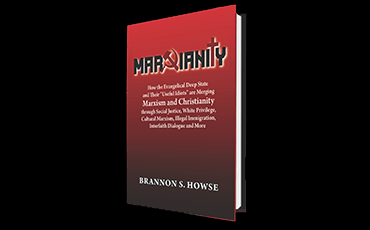Mike Bickel's International House of Prayer (IHOP) and A Manual for Mysticism
By Brannon S. Howse
I’ve already touched on the problem of Christian leaders participating in gatherings of a generally spiritual nature, but let’s take a further look at the August 6, 2011 prayer rally hosted by Texas governor Rick Perry. The Response website lists the leadership team for the event, and it includes several people associated with The International House of Prayer in Kansas City. As I’ve already pointed out, IHOP-KC has been described by numerous researchers and theologians as “cult-like.” One IHOP leader who appeared on the platform at The Response was the group’s founder, Mike Bickle. A quick review of the IHOP website bookstore reveals the unbiblical philosophies embraced by Pastor Bickle and his organization. Yet, the president of one of America’s largest pro-family organizations wrote me a four-page letter in the month of the event, ridiculing me for warning Christians of the unbiblical nature of The Response. Not surprisingly, his organization had assisted in organizing and promoting the event.
This pro-family leader sent his letter not only to me but to my pastor, several of my friends, and my Worldview Weekend speakers. Since he chose to make the letter public, I have no hesitation in sharing parts of it with you. I will, however, not mention the individual or his organization here because I want the issue to be about principle and not about individuals who may think I am on the attack.
The letter argued that “the International House of Prayer and Cindy Jacobs ministries have statements of faith that are solid.” I will tell you, though, that it is not uncommon for false teachers to have statements of faith on their websites that pass muster with the undiscerning who look no further. But from further research, I can say that even a cursory review of the writings and teaching of Cindy Jacobs and Mike Bickle reveal that neither Jacobs nor Bickle teach a biblically solid faith.
My personal warnings to this and other pro-family leaders concerning the false theologies of Jacobs and IHOP-KC were ignored. Let me share with you, though, some of the information the folks I cautioned have ignored in order to justify uniting and partnering with participants of the New Apostolic Reformation and Word of Faith movements.
A Manual for Mysticism
The book Fire Within: St. Theresa of Avila, St. John of the Cross, and the Gospel on Prayer, written by Catholic priest Thomas Dubay, promotes spiritual mysticism and contemplative prayer. Yet, Mike Bickle is quoted on the IHOP website as stating, “I want this book to be the manual for IHOP-KC.”
Amazon.com describes Fire Within this way:
[quote] This book is the fruit of Fr. Dubay’s many years of study and experience in spiritual direction and in it he synthesizes the teachings on prayer of the two great doctors of the Church on prayer—St. John of the Cross and St. Teresa of Avila—and the teaching of Sacred Scripture. [end quote]
Why would Bickle want a book that promotes the mysticism of St. Theresa of Avila “to be the manual for IHOP-KC” unless he is committed to mysticism. Wikipedia explains that “Saint Teresa of Avila…was a prominent Spanish mystic, Roman Catholic saint…and theologian of contemplative life through mental prayer.”
Under a section entitled “mysticism,” Wikipedia reports: “The kernel of Teresa’s mystical thought throughout all her writings is the ascent of the soul in four stages.” The four stages include, “mental prayer,” “prayer of quiet,” “devotion of union,” and “devotion of ecstasy or rapture.”
The fourth stage, “devotion of ecstasy or rapture,” is described by St. Teresa in her book Interior Castle:
[quote] The fourth is the “devotion of ecstasy or rapture,” a passive state, in which the consciousness of being in the body disappears (2 Corinthians 12:2-3). Sense activity ceases; memory and imagination are also absorbed in God or intoxicated. Body and spirit are in the throes of a sweet, happy pain, alternating between a fearful fiery glow, a complete impotence and unconsciousness, and a spell of strangulation, intermitted sometimes by such an ecstatic flight that the body is literally lifted into space. This after half an hour is followed by a reactionary relaxation of a few hours in a swoon-like weakness, attended by a negation of all the faculties in the union with God. From this the subject awakens in tears; it is the climax of mystical experience, productive of the trance. [end quote]
Cathleen Medwick’s Teresa of Avila: The Progress of a Soul recounts that Teresa at times levitated during this process:
[quote] Teresa’s rapture became so frequent as to be almost commonplace....The occasional visitor, like Bishop Alvaro de Mendoza, might be astonished to see the prioress, her hands pressed forward in prayer and her eyes rolled up to heaven, rise a foot or more off the ground. Teresa ordered that any sister who happened to be present during one of these levitations was to grab hold of her habit and try to hold her down. This, of course, was impossible, obedience being no match for celestial magnetism. [end quote]
Interior Castle is described on Amazon.com as follows:
[quote] Celebrated for almost five centuries as a master of spiritual literature, St. Teresa of Avila is one of the most beloved religious figures in history. Overcome one day by a mystical vision of a crystal castle with seven chambers, each representing a different stage in the soul’s spiritual quest for union with God, Teresa recorded her vision in this now classic text. Probably her most important and widely studied work, The Interior Castle guides the spiritual seeker through each chamber of the castle to the center and the soul’s final union with the divine.
Free of religious dogma, this contemporary rendering is a beautiful and practical set of teachings for seekers of all faiths in need of guidance. Mirabai Starr’s introduction places this classic in a contemporary context, reasserting its spiritual and literary importance close to five hundred years after it was first published. [end quote]
When I typed “contemplative prayer” into Wikipedia’s search engine, St. Teresa of Avila and St. John of the Cross were key figures in the site’s three-page report. The word “mysticism” was used numerous times in their description of contemplative prayer. Wikipedia offers an eye-opening description of Teresa’s four stages of prayer:
[quote] Saint Teresa of Avila described four degrees or stages of mystical union:
incomplete mystical union, or the prayer of quiet or supernatural recollection, when the action of God is not strong enough to prevent distractions, and the imagination still retains a certain liberty;
full or semi-ecstatic union, when the strength of the divine action keeps the person fully occupied but the senses continue to act, so that by making an effort, the person can cease from prayer;
ecstatic union, or ecstasy, when communications with the external world are severed or nearly so, and one can no longer at will move from that state; and
transforming or deifying union, or spiritual marriage (properly) of the soul with God. [end quote]
Notice again the fourth stage includes becoming one with God and becoming divine. This is not so surprising if you are aware that the Church of Rome has for years promoted the idea that man can become as God.
The Catholic Catechism, item #460, declares:
[quote] The Word became flesh to make us “partakers of the divine nature.” “For this is why the Word became man, and the Son of God became the Son of man: so that man, by entering into communion with the Word and thus receiving divine sonship, might become a son of God.” “For the Son of God became man so that we might become God.” “The only-begotten Son of God, wanting to make us sharers in his divinity, assumed our nature, so that he, made man, might make men gods.” [end quote]
The IHOP’s website also promotes a CD set by Mike Bickle entitled “Contemplative Prayer: The Journey into Fullness.” In it, Bickle declares:
[quote] mystics is a legitimate term... I don’t want to fight the war…so I’m just saying contemplative prayer, but I mean the mystics—even here at IHOP I say, let’s just stay with contemplatives …I don’t have time to argue… so I call them the contemplatives…. I don’t want to go into the semantics, the debates…so, I’m calling it the contemplatives… I don’t have time to argue… but I mean the mystics.
…a study of the lives of the mystics, the contemplatives, through history, and clearly the most inspiring, compelling examples of history, in my world, have come out of the Catholic dark ages. I can’t find anything like it in modern times, in America, in the Protestant world. [end quote]
And the bookstore also offers Henri Nouwen’s Clowning in Rome for which the product description describes Nouwen as “renowned contemplative author.” Despite what members of today’s New Religious Right declare, IHOP-KC and Bickle are not promoting a biblical faith.
Copyright 2012 ©Brannon Howse. This content is for Situation Room members and is not to be duplicated in any form or uploaded to other websites without the express written permission of Brannon Howse or his legally authorized representative.




